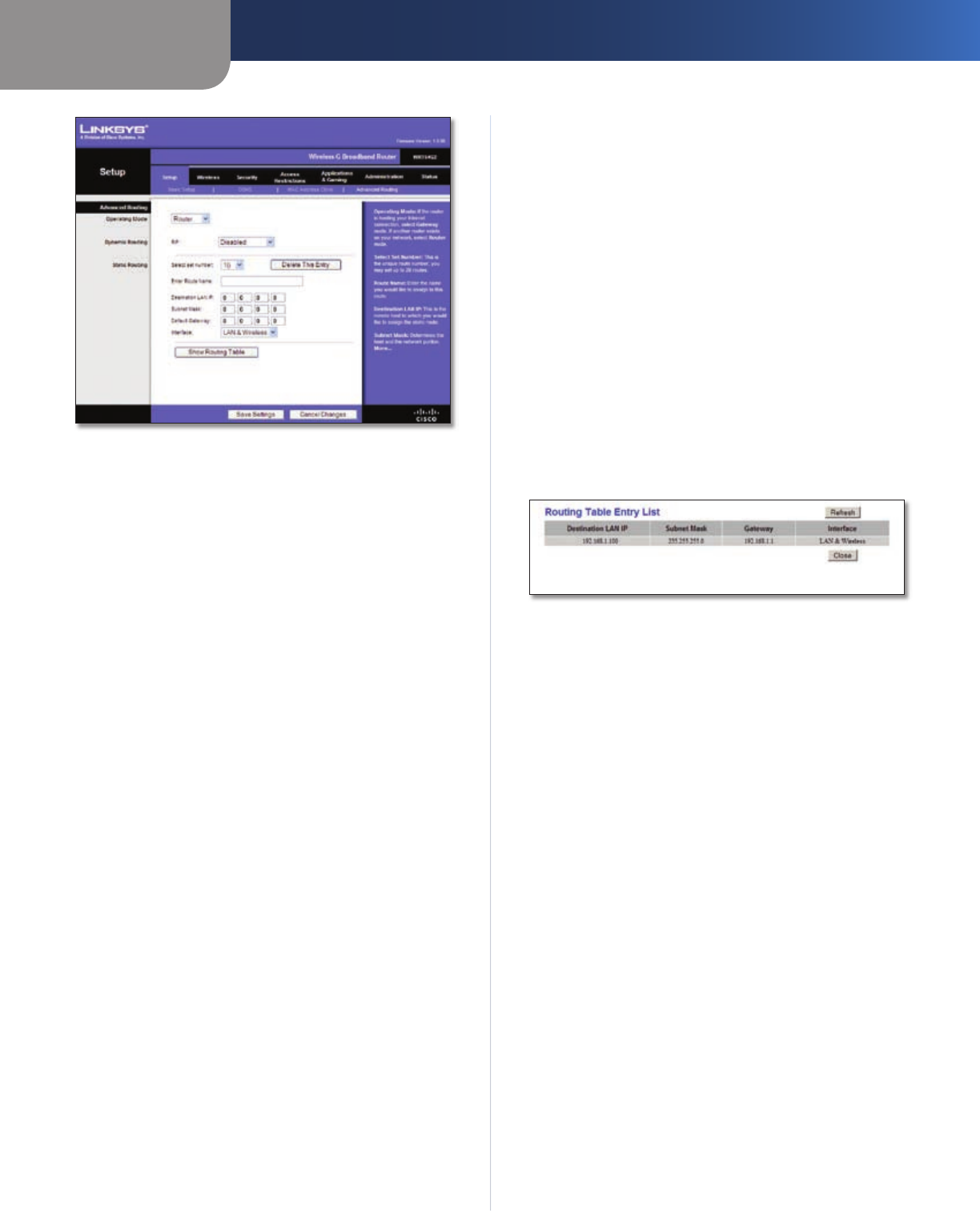
Chapter 3
Advanced Configuration
9
Wireless-G Broadband Router
Setup > Advanced Routing (Router )
Advanced Routing
Operating Mode Select the mode in which this Router
will function. If this Router is hosting your network’s
connection to the Internet, select Gateway. If another
Router exists on your network, select Router. When
Router is chosen, Dynamic Routing will be available as
an option.
Dynamic Routing
RIP This feature enables the Router to automatically
adjust to physical changes in the network’s layout and
exchange routing tables with the other router(s). The
Router determines the network packets’ route based on
the fewest number of hops between the source and the
destination. This feature is Disabled by default. From the
drop-down menu, you can also select LAN & Wireless,
which performs dynamic routing over your Ethernet and
wireless networks. You can also select WAN (Internet),
which performs dynamic routing with data coming from
the Internet. Finally, selecting Both enables dynamic
routing for both networks, as well as data from the
Internet.
Select set number To set up a static route between the
Router and another network, select a number from the
Static Routing drop-down list. (A static route is a pre-
determined pathway that network information must travel
to reach a specific host or network.) Enter the information
described below to set up a new static route. (Click the
Delete This Entry button to delete a static route.)
Enter Route Name Enter a name for the Route here,
using a maximum of 25 alphanumeric characters.
Destination LAN IP The Destination LAN IP is the address
of the remote network or host to which you want to assign
a static route.
Subnet Mask The Subnet Mask determines which
portion of a Destination LAN IP address is the network
portion, and which portion is the host portion.
Default Gateway This is the IP address of the gateway
device that allows for contact between the Router and the
remote network or host.
Interface This interface tells you whether the Destination
IP Address is on the LAN & Wireless (Ethernet and wireless
networks) or the WAN (Internet).
Delete This Entry To delete a route, select its number
from the drop-down menu, and click this button.
Show Routing Table Click Show Routing Table to open
a screen displaying how data is routed through your local
network. For each route, the Destination LAN IP address,
Subnet Mask, Gateway, and Interface are displayed. Click
Refresh to update the information. Click Close to exit this
screen.
Routing Table
Click Save Settings to apply your changes, or click Cancel
Changes to cancel your changes.
Wireless > Basic Wireless Settings
The basic settings for wireless networking are set on this
screen.
There are two ways to configure the Router’s wireless
network(s), manual and Wi-Fi Protected Setup.
Wi-Fi Protected Setup is a feature that makes it easy to set
up your wireless network. If you have client devices, such
as wireless adapters, that support Wi-Fi Protected Setup,
then you can use Wi-Fi Protected Setup.
Wireless Configuration To manually configure your
wireless network, select Manual. Proceed to the “Basic
Wireless Settings” section. To use Wi-Fi Protected Setup,
select Wi-Fi Protected Setup. Proceed to the “Wi-Fi
Protected Setup” section.
